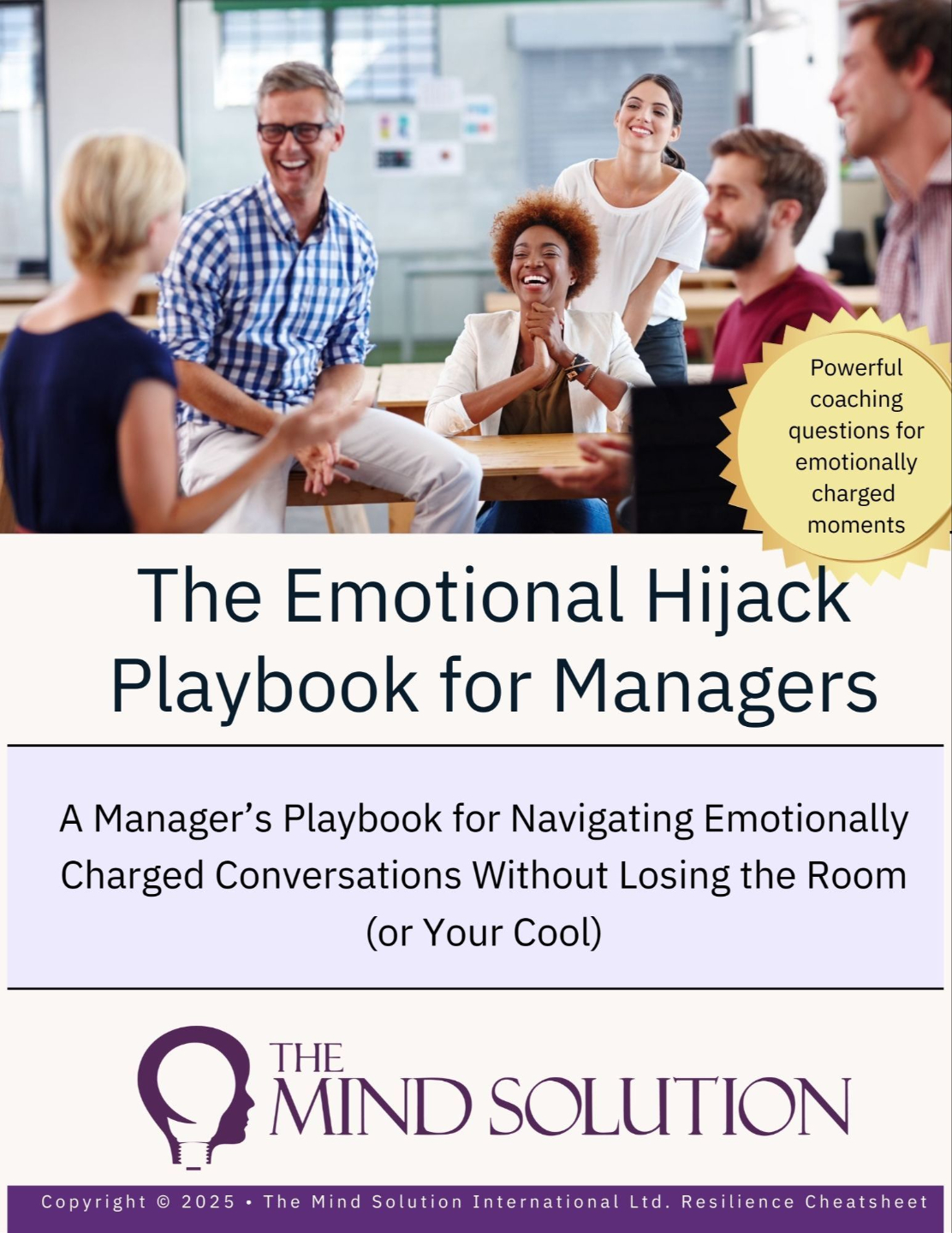How to Build Emotional Resilience in the Workplace
Nov 03, 2025
Over the last five years, the world of work has experienced seismic change.
We’ve navigated our way through a global pandemic, where, if there was ever a time people needed emotional resilience, it was then. Since COVID, employees have had to continually adapt to new ways of working.
Hybrid and remote models have changed the landscape of how we connect. In many cases, these new ways of working have created a sense of disconnection with teams who are constantly online, colleagues who rarely see one another in person, and those everyday human touchpoints that once brought warmth and connection into the workplace have quietly dissolved.
Add to that the rise of AI, and it can feel as though, just to make it through the last five years, we’ve needed a crash helmet.
So, it’s perhaps not surprising that we’ve seen a significant spike in the demand for emotional resilience training, whether in the form of employee wellbeing webinars, manager training, or full-scale resilience programmes.
What’s become clear is that in order to face whatever comes next, whether tomorrow or five years from now, we need to create a foundation of emotional resilience within the workplace.
What Is Emotional Resilience?
The term resilience itself can mean many things to many people. Often it’s associated with the ability to “bounce back” from challenge or adversity.
But emotional resilience goes deeper than that.
Where traditional resilience can sometimes imply pushing through despite the pressure, emotional resilience is about being able to stay grounded, self-aware, and emotionally regulated while navigating those challenges.
It’s about remaining present in the face of uncertainty, maintaining clarity of thought when emotions run high, and having the self-awareness to recognise when your nervous system is dysregulated, and knowing what to do about it.
At the heart of emotional resilience lies one key skill: self-awareness.
If people aren’t aware of their emotions, their emotional responses to situations, their beliefs, or their behaviours, then both their resilience and their emotional intelligence will be compromised.
Because when we’re unaware of our habitual patterns of thought and reaction, we’re simply being run by them.
When we are aware, we have a choice.
And that choice, the ability to step back, self-regulate, and respond rather than react, is what allows emotional resilience to flourish.
Emotional Resilience vs Emotional Intelligence
This is an interesting distinction because there’s such great overlap between the two.
Both are rooted in self-awareness. Both are about understanding the mind and body, recognising emotional patterns, and cultivating conscious responses rather than unconscious reactions.
If we were to draw a simple distinction, we could say that emotional resilience helps us navigate challenge, whereas emotional intelligence helps us navigate relationships.
Yet the truth is, they interweave beautifully.
With bespoke training, we can blend the facets of both, giving people a deeper understanding of how the mind and body function and how to navigate day-to-day life from an optimal state of being.
And the return on investment for this kind of development is tangible.
- You’ll see it in more harmonious relationships in the workplace.
- You’ll feel it in client interactions.
- You’ll notice it in how teams handle pressure, with calm, clarity, and composure.
These things are measurable. They show up in customer feedback, engagement surveys, and in the energy of how your culture feels.
As Maya Angelou famously said, “People will forget what you said, forget what you did, but they’ll never forget how you made them feel.”
Building emotional resilience in the workplace is a win-win for individuals, for teams, and for the organisation as a whole.
When people operate from greater self-awareness, they naturally respond to one another in ways that make people feel seen, valued, and safe. And when it comes to clients and customers, that’s what people buy.
How to Build Emotional Resilience in the Workplace
When it comes to building emotional resilience within an organisation, I would always encourage interactive training.
Whether you begin with a wellbeing webinar to introduce the concept, or move into in-depth workshops, as we do with our HR and leadership teams, the benefit of making sessions interactive is that it sparks minds into reflection.
It encourages self-enquiry.
It reframes thinking.
It challenges beliefs.
And all of that is the foundation of emotional resilience.
Because emotional resilience isn’t built through theory, it’s built through experience.
That’s why, in my view, it’s not enough to rely solely on employee wellbeing platforms or e-learning modules. While these platforms can be a fantastic resource, many now include mindfulness sessions or EFT tapping for emotional regulation (which is brilliant, by the way) they rely on one crucial factor: people actually using them.
And that’s often the biggest challenge with voluntary platforms or wellbeing apps. You can offer them, but that doesn’t mean people will engage.
Interactive training, on the other hand, brings the subject to life. It allows people to learn through story, metaphor, and discussion—the kind of learning that helps individuals see whatever they personally need to see in order to grow.
It expands awareness.
It helps people notice the unconscious patterns that have been quietly running their show 95% of the time.
And it creates space for real transformation.
Why Emotional Resilience Is Important
If we look back over the last few years, it’s clear that employees have been asked to adapt, stretch, and evolve in extraordinary ways.
Many people are now working in environments that look and feel completely different from how they did pre-2020.
For some, hybrid working has brought greater balance. For others, it’s brought loneliness and disconnection.
Couples now cohabiting and working together have had to adjust to entirely new dynamics. Teams have shifted from in-person collaboration to virtual communication. And leaders are being asked to motivate, connect, and support people they rarely meet face-to-face.
Against that backdrop, emotional resilience isn’t a “nice to have.” It’s a non-negotiable skill for the future of work.
Emotionally resilient employees are able to adapt more quickly, stay grounded through uncertainty, and maintain healthy boundaries between work and home life.
They’re also better able to connect, to listen deeply, to empathise, and to make clear, wise decisions even under pressure.
And when that kind of emotional clarity becomes embedded across a business, it transforms culture.
Measuring the Impact
If you’re exploring emotional resilience training for your organisation, start small.
You might choose to pilot it within a single department, perhaps your sales team, where the pressure of meeting targets can create emotional strain.
Or you might focus on a business area going through significant change or restructuring, where uncertainty can easily impact wellbeing and performance.
The results of this kind of training can be seen not only in how people feel, but in how they show up. It’s reflected in improved collaboration, calmer communication, and greater confidence in navigating challenges.
In short, it’s the gift that keeps on giving.
Because when we build emotional resilience in the workplace, we’re not just helping people cope, we’re helping them thrive.
Begin Building Emotional Resilience in Your Organisation
If you’d like to explore how to build emotional resilience within your organisation, I’d love to help.
From interactive training and leadership development to tailored employee wellbeing webinars, we help organisations strengthen their foundation of emotional resilience—so your people can perform, connect, and lead from a place of calm clarity.
You can book a call here to talk about how emotional resilience training can support your people.
Because the future of work demands more than just resilience. It calls for emotional resilience, awareness, connection, and the capacity to thrive in the midst of change.
The Emotional Hijack Playbook For Managers
A Manager’s Free Resource for Navigating Emotionally Charged Conversations Without Losing the Room (or Your Cool).
Perfect to use in your next one-to-one.






